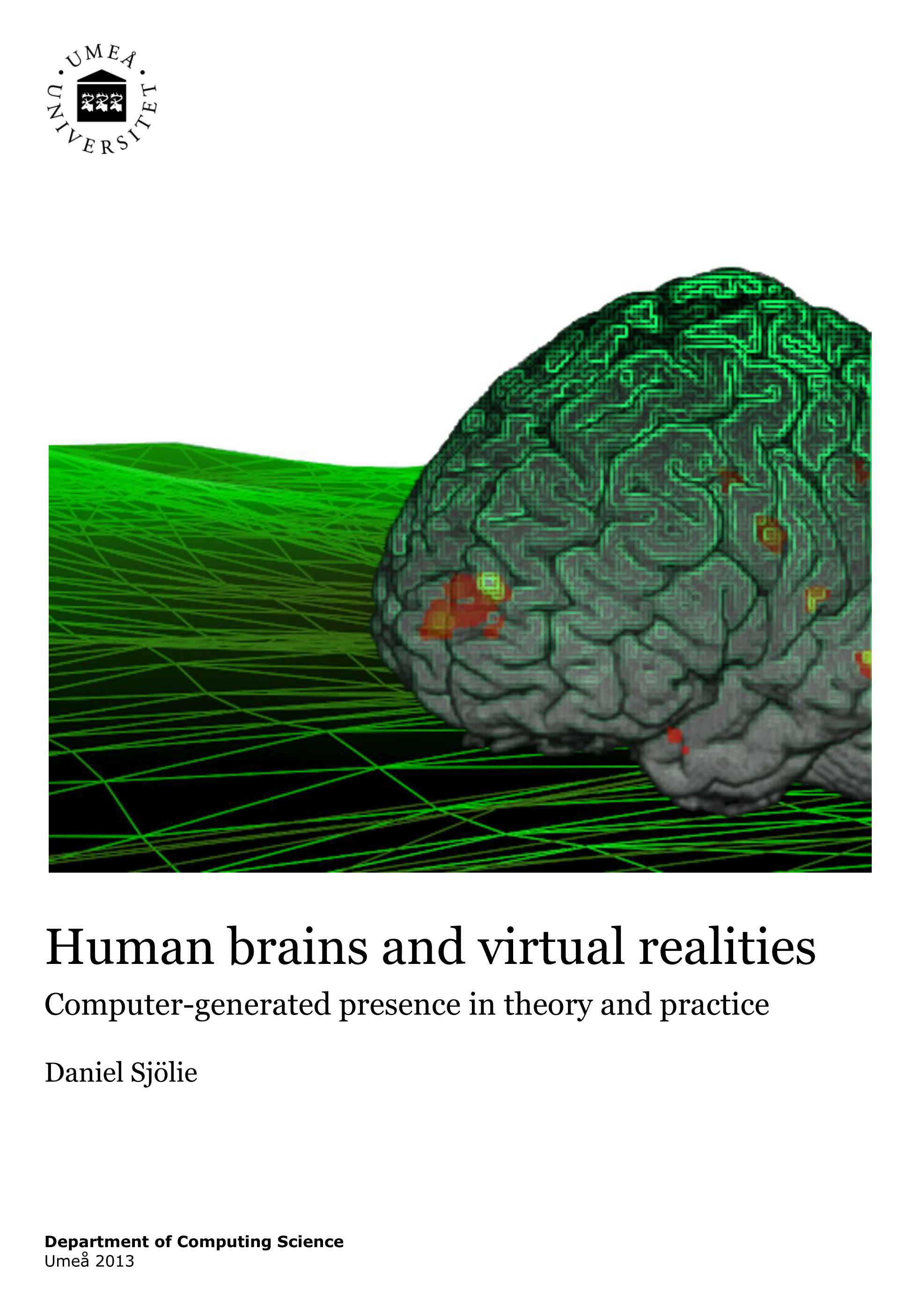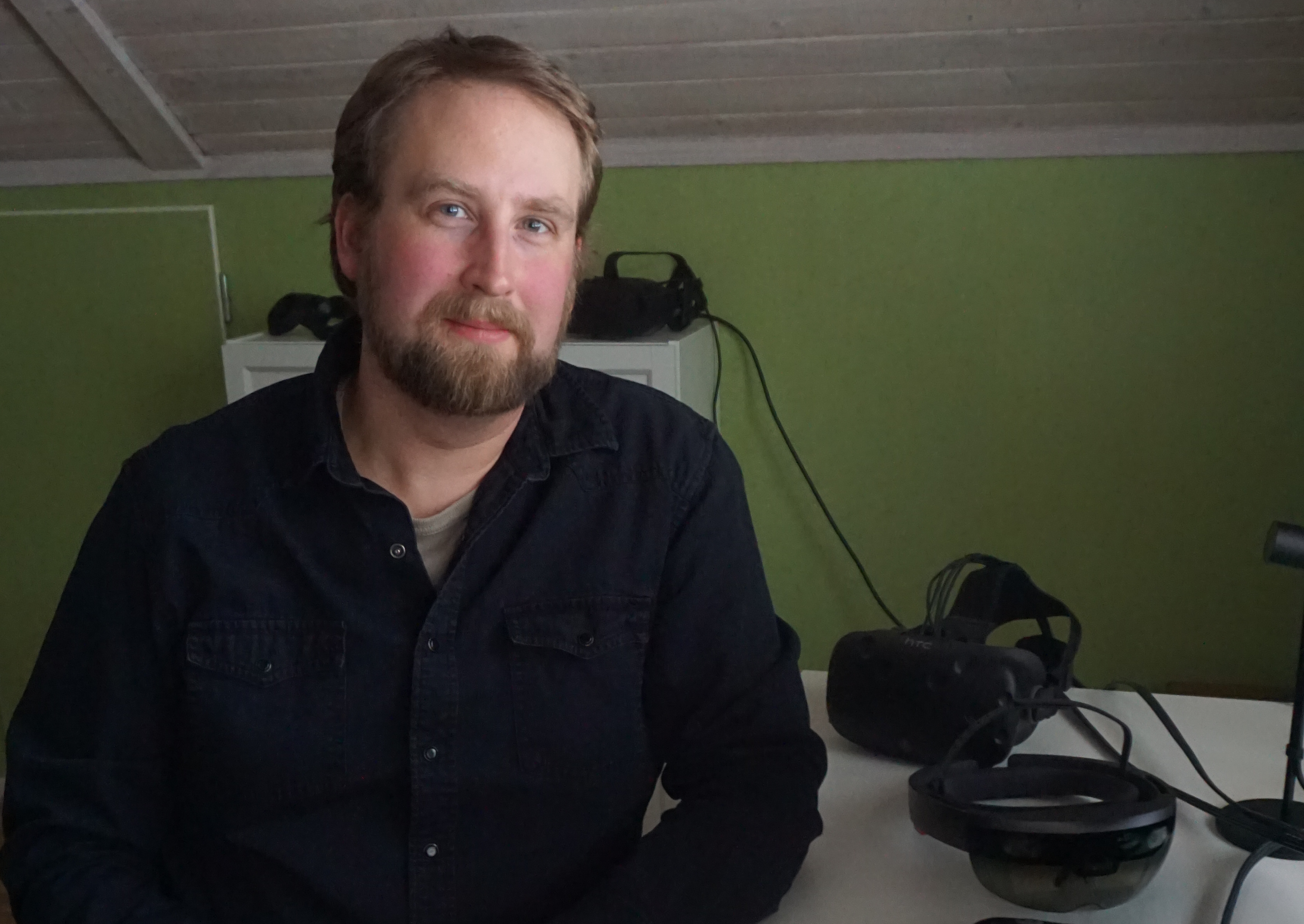Background
I am a Senior Lecturer at the Division of Informatics, School of Business, Economics and IT at University West focusing on Virtual and Mixed Reality. I have worked with Virtual Reality since around 2000, first as a research engineer developing VR systems and then as a researcher focusing on connecting VR-technology to an understanding of human cognition and human brain function. During my PhD-research I was associated with Umeå center for Functional Brain Imaging.
After finishing my PhD at Umeå University in 2013 I briefly held a position at the University of Skövde (Senior Lecturer 2013-2014) focusing on computer game development and design. This was followed by a position in Gothenburg (Associate Senior Lecturer 2014-2019) covering interaction design, visualization and VR before ending up in Trollhättan, from 2018.
Among my primary interests are the foundations in cognitive neuroscience for phenomena related to VR and gaming, such as presence and engagement, and the application of such understanding to benefit the design of VR and Mixed Reality computer applications.
Human brains and virtual realities
Doctoral Thesis (Summary)

My doctoral thesis, Human brains and virtual realities - Computer generated presence in theory and practice focuses on how theory about human brain function can be integrated with brain measurements in virtual environments to inform and guide the development of realistic computer applications designed "for the brain".
The research explores the concept of "presence" — the subjective feeling of being in a place that feels real — as a cornerstone for understanding the relationship between human brains and virtual realities. By combining theoretical discussions with functional MRI measurements of brain activity during realistic interaction in virtual environments, the work provides insights into how VR can be designed to better align with the natural functioning of the human brain.
While VR technology provides an excellent platform for investigating presence, the thesis argues that presence should be understood as a general cognitive function not specifically tied to virtual reality. This broader interpretation allows the same principles to be applied across various applications and contexts.
Thesis Abstract

A combined view of the human brain and computer-generated virtual realities is motivated by recent developments in cognitive neuroscience and human-computer interaction (HCI). The emergence of new theories of human brain function, together with an increasing use of realistic human-computer interaction, give reason to believe that a better understanding of the relationship between human brains and virtual realities is both possible and valuable. The concept of "presence", described as the subjective feeling of being in a place that feels real, can serve as a cornerstone concept in the development of such an understanding, as computer-generated presence is tightly related to how human brains work in virtual realities.
In this thesis, presence is related both to theoretical discussions rooted in theories of human brain function, and to measurements of brain activity during realistic interaction. The practical implications of such results are further developed by considering potential applications. This includes the development and evaluation of a prototype application, motivated by presented principles.
The theoretical conception of presence in this thesis relies on general principles of brain function, and describes presence as a general cognitive function, not specifically related to virtual realities. Virtual reality (VR) is an excellent technology for investigating and taking advantage of all aspects of presence, but a more general interpretation allows the same principles to be applied to a wide range of applications.
Functional magnetic resonance imaging (fMRI) was used to study the working human brain in VR. Such data can inform and constrain further discussion about presence. Using two different experimental designs we have investigated both the effect of basic aspects of VR interaction, as well as the neural correlates of disrupted presence in a naturalistic environment.
Reality-based brain-computer interaction (RBBCI) is suggested as a concept for summarizing the motivations for, and the context of, applications building on an understanding of human brains in virtual realities. The RBBCI prototype application we developed did not achieve the set goals, but much remains to be investigated and lessons from our evaluation point to possible ways forward. A developed use of methods and techniques from computer gaming is of particular interest.
Contact
Daniel Sjölie
School of Business,
Economics and IT
Division of Informatics
University West
SE-461 86 Trollhättan
Sweden
Email: daniel.sjolie@hv.se
Phone: +46 (0)701804704
Professional Profiles
CV
Employments
- Research engineer at VRlab, Umeå university, 2001-2008. Virtual reality and interactive 3d-graphics programming and development. Includes teaching.
- PhD student, Umeå university, 2008-2013. Focus on human-computer interaction and cognition, connected to hard computing science like interactive simulations and numeric analysis. Includes teaching.
- Senior lecturer, University of Skövde, 2013-2014. Teaching and master thesis supervision. Primarily related to computer graphics, computer games and web programming.
- Associate senior lecturer, University of Gothenburg, 2014-2019. Lecturing and research. Interaction design and visualization with a focus on virtual/mixed/augmented reality.
- Senior lecturer, University West, 2018-. My current position. Lecturing and research. Virtual/mixed/augmented reality.
Program Committees and Organizing
- CHI 2012 Associate chair, subcommittee on Interaction Using Specific Capabilities or Modalities.
- Presence 2014 Program committee.
- SIGRAD 2014 Co-chair.
- VRST 2017 Symposium Chair.
Awards
- Best paper at ICAT-EGVE 2014
- Neural correlates of disrupted presence: strange disruptions in a naturalistic virtual environment
Invited Talks
- Folkuniversitetet Borås 2017
- Trollywood Animation Festival 2017
- LINA lunch seminar 2016
- Human Reasoning Seminar, University of Gothenburg, spring 2014.
- SweCog conference fall 2013
Since 2018 I have done many invited talks as a representative for University West and Open lab, typically focusing on introducing VR/XR.
Teaching
I've been course responsible for seven courses, and responsible for modules in several more. This includes courses relating to computer graphics, introductory programming, game design and development, information visualization, cognitive perspectives on HMI, immersive media/computing, visualization for urban planning and quantitative reseach methods. Five of these I created from scratch. I've done many guest lectures about artificial intelligence, advanced computer graphics and virtual/mixed reality, and I have done a lot of supervision and grading related to student assignments and projects.
Technical Expertise
I've been programming for 30+ years, including 25+ years of computer graphics and visualization. I have a Master of Science in Computing Science and I have worked with software development as a research engineer, as part of my PhD studies, and as responsible for development in many research projects since. I've used more than 10 different programming languages seriously and tried many more. I'm regularly using and developing on Windows, Linux and OS X, and I've done app development for iOS, Android, and standalone VR such as Meta Quest. I've programmed and developed 3d-graphics applications in everything from assembler to javascript, including software like Unreal Engine, Maya and 3D Studio Max.
Undergraduate Education
Master of science in Computing science
Umeå universitet, Umeå, 1996 – 2002The education largely focused on programming and software development. Towards the end of the education, I focused mainly on courses in computer graphics and artificial intelligence. Good performance on the course in "Virtual Reality" (which later changed its name to "Advanced Computer Graphics") led to a position as research engineer at VRlab in the following years.
In my master's thesis I implemented an AI toolkit for controlling virtual characters in a virtual 3D environment.
Natural science high-school
Östraboskolan, Uddevalla, 1993 – 1996In high school I learned computer graphics programming on my own and implemented, e.g., a simulation of the solar system as a graduation project.
Additional Non-academic Experience
Military service
Platoon commander, Swedish artillery, A9, Kristinehamn, 1997 – 1998, 12 months.
Nonprofits and politics
Since high school I have often participated in a variety of associations and boards, several times as chairman. For example, I have served as chairman of the board in my previous condo association and in political youth organizations at local and district levels. My political involvement has also led to 8 years in the Environment and Health Committee in Umeå, and 4 years as a lay judge in the Administrative Court.
Publications
Exploring the intersection of virtual reality, cognition, and applied visualization through research.
You can also find these in my ResearchGate profile.
